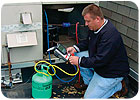
Honeywell’s Rooftop Retrocommissioning program checks the actual performance of a rooftop unit, and helps owners decide what to do next (repair, upgrade, or replace the equipment) to bring their energy consumption and reliability back in line.
Building owners will also be more interested in making sure their systems operate as efficiently as possible, as energy expenses continue to rise.
Mechanical system commissioning basically means someone verifies that a newly installed system works the way it’s supposed to work. Recommissioning means that a system’s operation is rechecked, and changes are recommended to bring it back up to its performance levels and to ensure that occupant requirements are being met.
Retrocommissioning means that a system, whose performance was never commissioned before, has its operation checked after what may be years of operation.
Honeywell’s rooftop retrocommissioning program offers to check the actual performance of a rooftop unit (RTU), and help owners decide what to do next (repair, upgrade, or replace the equipment) to bring their energy consumption and reliability back in line. Ideally, it should be followed up with a service contract and continuous commissioning to maintain the system’s performance over time, said Laura Inward, marketing manager for Honeywell Building Solutions.
Commissioning can, in fact, include every single part of a building. “It can be quite a detailed survey or audit,” she said. Honeywell can perform full building commissioning in conjunction with partners, but one reason it has now focused sharply on RTUs is because of the size of the market. “It’s estimated at $9 billion in the United States alone,” Inward said. It’s tracked to grow approximately 16 percent per year.
“Rooftop units are the unit of choice,” Inward said. “They are easier to maintain, less costly to replace, and they take up less space within the building.”
SYSTEM REPAIRS
Comfort may not be a primary concern for some building owners, and IAQ problems may not even be acknowledged by others, but energy expenses can get the attention of most decision makers.The company said the rooftop retrocommissioning program is able to reduce energy costs related to RTU operation up to 20 percent without capital investment (meaning no RTUs or major components need to be replaced).
Performance is evaluated using the company’s Service Assistant fault detection technology, Inward said.
“It allows us to hook up to the refrigeration section of the system, to the economizer, and to the airflow. It allows us to diagnose any problems with the rooftop unit, as well as the financial implications of not fixing it.
Retrocommissioning also can improve system reliability and equipment lifespan.”
According to Honeywell, “Proactive fault detection and diagnostic algorithms within the Service Assistant properly identify difficult-to-diagnose problems. This early and accurate diagnosis extends equipment life, reduces unexpected downtime, and maximizes comfort conditions.”
“It helps customers make better decisions about their equipment,” Inward said. “Decisions are based on facts and actual operation conditions.”
The commissioning performed by Honeywell technicians identifies problems, suggests repairs, and displays the payback value of the service.
“One of the things we hope to help the customer with,” Inward said, “is to make a decision based on the financial ramifications over time. Should they just bite the bullet and replace it?”
The report takes into account energy expenses and maintenance costs of an older unit. It also provides the customer with proof of service and peace of mind.
According to Inward, Honeywell has 1,400 service technicians across North America, and they can perform RTU replacements and repairs. However, they don’t need to if it doesn’t suit the owner’s needs.

Rooftop unit performance is evaluated using Service Assistant fault detection technology. According to Laura Inward, marketing manager for Honeywell Building Solutions, “It allows us to diagnose any problems with the rooftop unit, as well as the financial implications of not fixing it.”
SYSTEM ROLL OUT
The rooftop retrocommissioning program has been tested in a number of cities in the United States over the last year. Inward said the company is currently deploying throughout the United States and Puerto Rico, and piloting in Windsor (Ontario) and Vancouver (B.C.), Canada, this summer.“We’ve had a number of successes throughout our pilot program,” she said. Systems being tested have ranged in size from the smallest packaged systems, “up to the largest compressor. It’s not limited in size.”
After RTU repairs are made, system performance is verified again by the Service Assistant. “It compares system performance before and after any maintenance, repairs, upgrades, or replacements have been made,” Inward said.
Problems cited in the pilot programs, she said, have included those related to subcooling, superheat, and refrigerant charge; problems with expansion valves that could lead to compressor failure; and general problems with the refrigeration circuit, the economizer, and system airflow.
Service Assistant is available for purchase directly from Field Service Diagnostic Inc. Some features, however, are specific to Honeywell. “We have it fully integrated into our technology,” she said.
Technicians are able to be in constant connection with the company’s Global Service Response Center in Atlanta, which maintains a wealth of service and troubleshooting data, and coordinates the entire Honeywell service team. The reporting (which includes financial calculations, replacement justifications, and energy savings) is also unique to Honeywell’s program, Inward said.
For more information, visit www.honeywell.com or www.fielddiagnostics.com.
Publication Date:06/18/2007

Report Abusive Comment